新版专四语法总结
- 格式:doc
- 大小:102.00 KB
- 文档页数:28
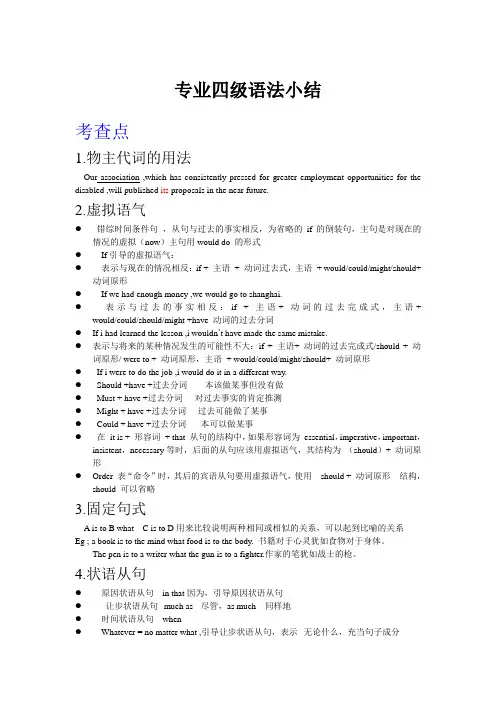
专业四级语法小结考查点1.物主代词的用法Our association ,which has consistently pressed for greater employment opportunities for the disabled ,will published its proposals in the near future.2.虚拟语气●错综时间条件句,从句与过去的事实相反,为省略的if的倒装句,主句是对现在的情况的虚拟(now)主句用would do 的形式●If引导的虚拟语气:●表示与现在的情况相反:if + 主语+ 动词过去式,主语+ would/could/might/should+动词原形●If we had enough money ,we would go to shanghai.●表示与过去的事实相反:if + 主语+ 动词的过去完成式,主语+would/could/should/might +have 动词的过去分词●If i had learned the lesson ,i wouldn’t have made the same mistake.●表示与将来的某种情况发生的可能性不大:if + 主语+ 动词的过去完成式/should + 动词原形/ were to + 动词原形,主语+ would/could/might/should+ 动词原形●If i were to do the job ,i would do it in a different way.●Should +have +过去分词------本该做某事但没有做●Must + have +过去分词----对过去事实的肯定推测●Might + have +过去分词----过去可能做了某事●Could + have +过去分词-----本可以做某事●在it is + 形容词+ that 从句的结构中,如果形容词为essential,imperative,important,insistent,necessary等时,后面的从句应该用虚拟语气,其结构为(should)+ 动词原形●Order 表“命令”时,其后的宾语从句要用虚拟语气,使用should + 动词原形结构,should 可以省略3.固定句式A is toB whatC is to D用来比较说明两种相同或相似的关系,可以起到比喻的关系Eg ; a book is to the mind what food is to the body. 书籍对于心灵犹如食物对于身体。
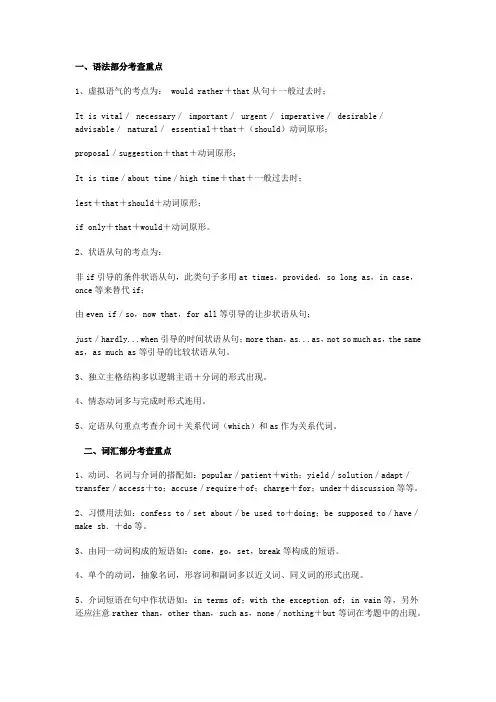
一、语法部分考查重点1、虚拟语气的考点为: would rather+that从句+一般过去时;It is vital/ necessary/ important/ urgent/ imperative/ desirable/advisable/ natural/ essential+that+(should)动词原形;proposal/suggestion+that+动词原形;It is time/about time/high time+that+一般过去时;lest+that+should+动词原形;if only+that+would+动词原形。
2、状语从句的考点为:非if引导的条件状语从句,此类句子多用at times,provided,so long as,in case,once等来替代if;由even if/so,now that,for all等引导的让步状语从句;just/hardly...when引导的时间状语从句;more than,as...as,not so much as,the same as,as much as等引导的比较状语从句。
3、独立主格结构多以逻辑主语+分词的形式出现。
4、情态动词多与完成时形式连用。
5、定语从句重点考查介词+关系代词(which)和as作为关系代词。
二、词汇部分考查重点1、动词、名词与介词的搭配如:popular/patient+with;yield/solution/adapt/transfer/access+to;accuse/require+of;charge+for;under+discussion等等。
2、习惯用法如:confess to/set about/be used to+doing;be supposed to/have/make sb.+do等。
3、由同一动词构成的短语如:come,go,set,break等构成的短语。

英语专四语法总结1.主谓一致就近原则1.由并列结构或连词(either…or,neither…nor,not…but,not only…but also,or 等)连接的并列主语,谓语动词与靠近的那个名词或代词保持一致。
2. 在倒装句和there be句型中,谓语动词与后面的第一个主语保持一致。
例句:There is a book and some pens on the desk.桌子上有一本书和几支钢笔。
3. 在强调句中,连接代词又在句中作主语,这时它应与被强调的主语保持一致。
例句:It is Ma ry’s brother who was injured in the car accident. 是Mary的哥哥在车祸中受伤了。
意义一致原则1. 当主语与谓语动词之间插入along with,with,as well as,together with,no less than,besides,except,but,including 等短语时,谓语动词不受这些插入语的干扰,依然和主语保持一致。
例句:I, along with my sister, am going to Shanghai next month.我,还有我姐姐,打算下个月去上海。
2. 英语中有一类单、复数同型的词(people,means,sheep,deer,fish 等),其单、复数取决于它在句中的含义。
例句:All of the people in the country have been prepared for thegreat reformation.这个国家的人都已经为大变革做好了准备。
3. 多数情况下,由“what”引导的名词性从句作主语时,其后的谓语动词通常用单数形式。
我只想说:“多保重!”例句:What I want to say is just “ Take care!”.4. 当主语与all,none,any,some等不定代词、形容词连用时,应根据具体句意,来决定其后的谓语动词的单复数。
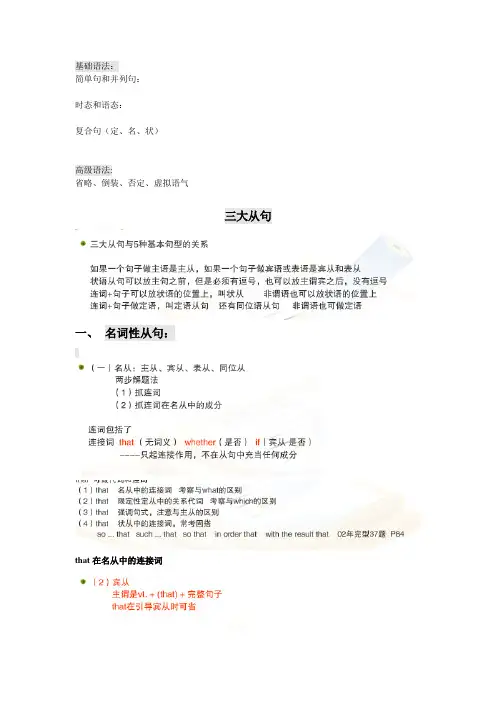
基础语法:简单句和并列句:时态和语态:复合句(定、名、状)高级语法:省略、倒装、否定、虚拟语气三大从句一、名词性从句:that在名从中的连接词that在定语从句中whatWhat与How的区别:However之后没有形容词或者副词,排除D;what与whatever做主宾表成分,后面的从句不缺少成分,排除AB。
……change the way()American eat.是定语从句!定语从句名词不考虑what 动词不考虑which主谓不及物加状语完整的句子Such that 完整的句子such as 缺成分so as to such as to的用法~ ??????看到选项中有however首次考虑有没有逗号有没有副词形容词Whose 既可以引导限定定语从句又可以引导非限定定语从句,当两边都是名词时选择这个状语从句Although native to America,the plant can be seen everythere in the world now.是介词,不可引导句子~~~ 2、让步状从3、条件状从provide~引导条件状从This is the house where I once lived.是定语从句还是地点状从???Where前面有地点名词考虑定语从句。
when引导的定语从句与时间状语从句的区别~方式状从:非限定定语从句:as 引导的非限,指代前面的句子as 引导限从时,寻找such as和the same as从词义上区分~as引导的方式状从~又是一个as的考点选项中优先考虑however 和what首先判断however后有没有出现,若出现则翻译成“但是”;若没有出现则判断是否出现形容词或者副词,翻译成“无论”Although he may be dullDull as he may be…圈出很重要的逗号,记住:逗号两边不能连接两个完整的句子本题中需要找一个连词。

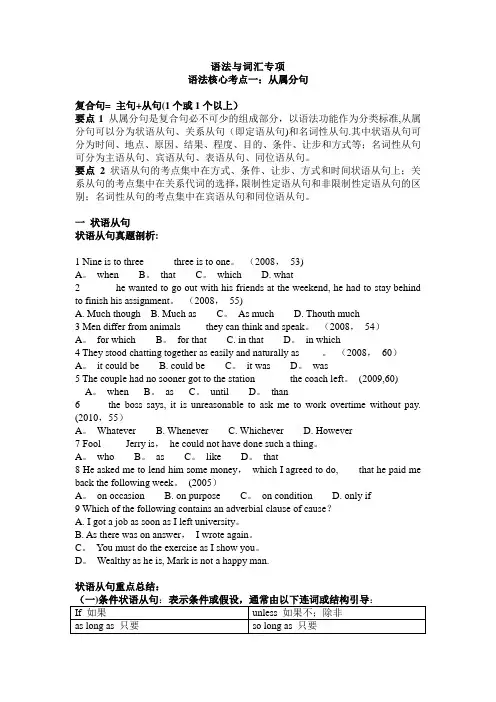
语法与词汇专项语法核心考点一:从属分句复合句= 主句+从句(1个或1个以上)要点1从属分句是复合句必不可少的组成部分,以语法功能作为分类标准,从属分句可以分为状语从句、关系从句(即定语从句)和名词性从句.其中状语从句可分为时间、地点、原因、结果、程度、目的、条件、让步和方式等;名词性从句可分为主语从句、宾语从句、表语从句、同位语从句。
要点 2 状语从句的考点集中在方式、条件、让步、方式和时间状语从句上;关系从句的考点集中在关系代词的选择,限制性定语从句和非限制性定语从句的区别;名词性从句的考点集中在宾语从句和同位语从句。
一状语从句状语从句真题剖析:1 Nine is to three _____ three is to one。
(2008,53)A。
when B。
that C。
which D. what2 ______ he wanted to go out with his friends at the weekend, he had to stay behind to finish his assignment。
(2008,55)A. Much thoughB. Much as C。
As much D. Thouth much3 Men differ from animals ____ they can think and speak。
(2008,54)A。
for which B。
for that C. in that D。
in which4 They stood chatting together as easily and naturally as ____。
(2008,60)A。
it could be B. could be C。
it was D。
was5 The couple had no sooner got to the station ______ the coach left。
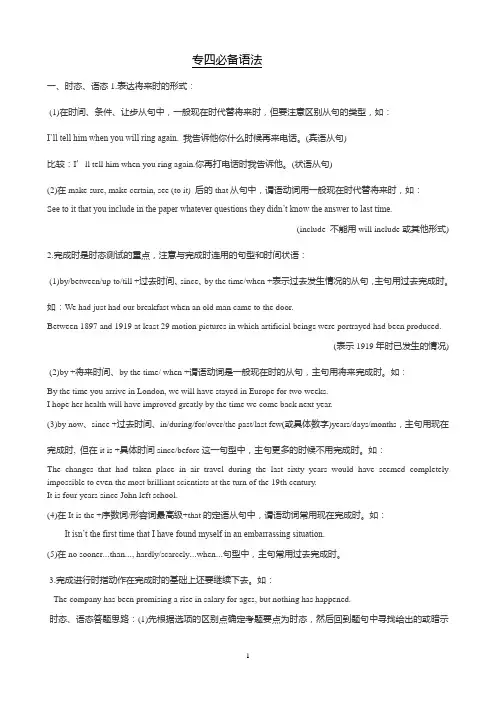
专四必备语法一、时态、语态1.表达将来时的形式:(1)在时间、条件、让步从句中,一般现在时代替将来时,但要注意区别从句的类型,如:I’ll tell him when you will ring again. 我告诉他你什么时候再来电话。
(宾语从句)比较:I’ll tell him when you ring again.你再打电话时我告诉他。
(状语从句)(2)在make sure, make certain, see (to it) 后的that从句中,谓语动词用一般现在时代替将来时,如:S ee to it that you include in the paper whatever questions they didn’t know the answer to last time.(include 不能用will include或其他形式) 2.完成时是时态测试的重点,注意与完成时连用的句型和时间状语:(1)by/between/up to/till +过去时间、since、by the time/when +表示过去发生情况的从句,主句用过去完成时。
如:We had just had our breakfast when an old man came to the door.Between 1897 and 1919 at least 29 motion pictures in which artificial beings were portrayed had been produced.(表示1919年时已发生的情况) (2)by +将来时间、by the time/ when +谓语动词是一般现在时的从句,主句用将来完成时。
如:By the time you arrive in London, we will have stayed in Europe for two weeks.I hope her health will have improved greatly by the time we come back next year.(3)by now、since +过去时间、in/during/for/over/the past/last few(或具体数字)years/days/months,主句用现在完成时, 但在it is +具体时间since/before这一句型中,主句更多的时候不用完成时。
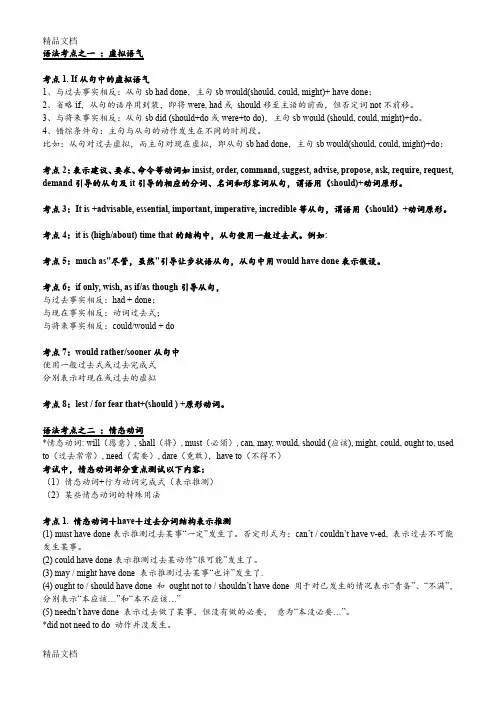
语法考点之一:虚拟语气考点1. If从句中的虚拟语气1、与过去事实相反:从句sb had done,主句sb would(should, could, might)+ have done;2、省略if,从句的语序用到装,即将were, had或should移至主语的前面,但否定词not不前移。
3、与将来事实相反:从句sb did (should+do或were+to do),主句sb would (should, could, might)+do。
4、错综条件句:主句与从句的动作发生在不同的时间段。
比如:从句对过去虚拟,而主句对现在虚拟,即从句sb had done,主句sb would(should, could, might)+do;考点2:表示建议、要求、命令等动词如insist, order, command, suggest, advise, propose, ask, require, request, demand引导的从句及it引导的相应的分词、名词和形容词从句,谓语用(should)+动词原形。
考点3:It is +advisable, essential, important, imperative, incredible等从句,谓语用(should)+动词原形。
考点4:it is (high/about) time that的结构中,从句使用一般过去式。
例如:考点5:much as"尽管,虽然"引导让步状语从句,从句中用would have done表示假设。
考点6:if only, wish, as if/as though引导从句,与过去事实相反:had + done;与现在事实相反:动词过去式;与将来事实相反:could/would + do考点7:would rather/sooner从句中使用一般过去式或过去完成式分别表示对现在或过去的虚拟考点8:lest / for fear that+(should ) +原形动词。
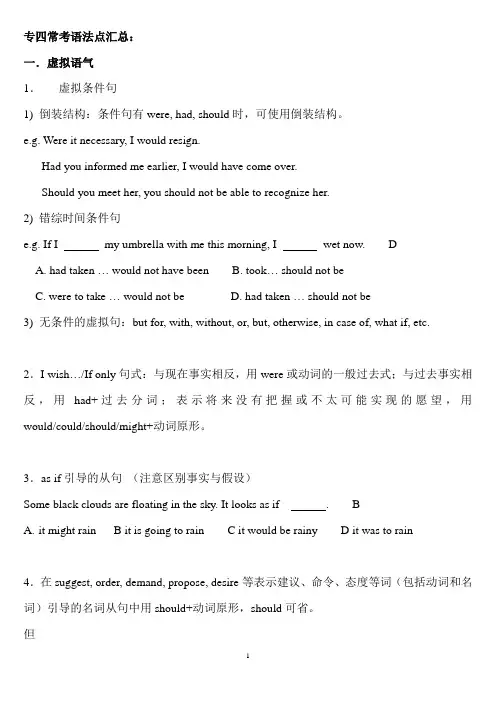
专四常考语法点汇总:一.虚拟语气1.虚拟条件句1) 倒装结构:条件句有were, had, should时,可使用倒装结构。
e.g. Were it necessary, I would resign.Had you informed me earlier, I would have come over.Should you meet her, you should not be able to recognize her.2) 错综时间条件句e.g. If I my umbrella with me this morning, I wet now. DA. had taken … would not have beenB. took… should not beC. were to take … would not beD. had taken … should not be3) 无条件的虚拟句:but for, with, without, or, but, otherwise, in case of, what if, etc.2.I wish…/If only句式:与现在事实相反,用were或动词的一般过去式;与过去事实相反,用had+过去分词;表示将来没有把握或不太可能实现的愿望,用would/could/should/might+动词原形。
3.as if引导的从句(注意区别事实与假设)Some black clouds are floating in the sky. It looks as if . BA.it might rain B it is going to rain C it would be rainy D it was to rain4.在suggest, order, demand, propose, desire等表示建议、命令、态度等词(包括动词和名词)引导的名词从句中用should+动词原形,should可省。
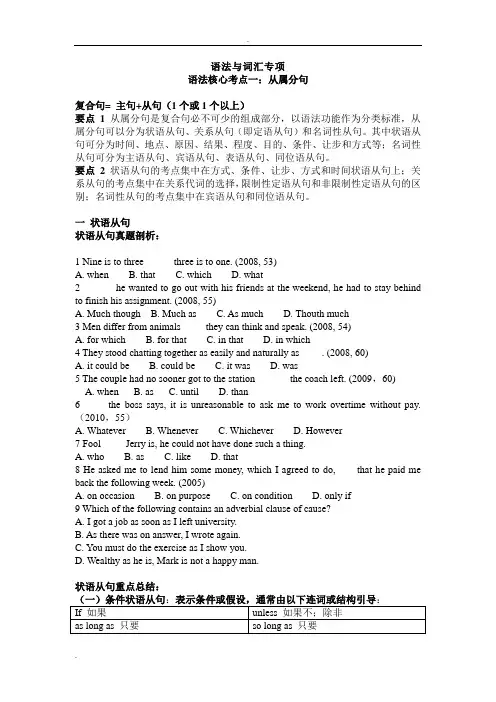
语法与词汇专项语法核心考点一:从属分句复合句= 主句+从句(1个或1个以上)要点1从属分句是复合句必不可少的组成部分,以语法功能作为分类标准,从属分句可以分为状语从句、关系从句(即定语从句)和名词性从句。
其中状语从句可分为时间、地点、原因、结果、程度、目的、条件、让步和方式等;名词性从句可分为主语从句、宾语从句、表语从句、同位语从句。
要点 2 状语从句的考点集中在方式、条件、让步、方式和时间状语从句上;关系从句的考点集中在关系代词的选择,限制性定语从句和非限制性定语从句的区别;名词性从句的考点集中在宾语从句和同位语从句。
一状语从句状语从句真题剖析:1 Nine is to three _____ three is to one. (2008, 53)A. whenB. thatC. whichD. what2 ______ he wanted to go out with his friends at the weekend, he had to stay behind to finish his assignment. (2008, 55)A. Much thoughB. Much asC. As muchD. Thouth much3 Men differ from animals ____ they can think and speak. (2008, 54)A. for whichB. for thatC. in thatD. in which4 They stood chatting together as easily and naturally as ____. (2008, 60)A. it could beB. could beC. it wasD. was5 The couple had no sooner got to the station ______ the coach left. (2009,60)A. whenB. asC. untilD. than6 ____ the boss says, it is unreasonable to ask me to work overtime without pay. (2010,55)A. WhateverB. WheneverC. WhicheverD. However7 Fool ____ Jerry is, he could not have done such a thing.A. whoB. asC. likeD. that8 He asked me to lend him some money, which I agreed to do, ___ that he paid me back the following week. (2005)A. on occasionB. on purposeC. on conditionD. only if9 Which of the following contains an adverbial clause of cause?A. I got a job as soon as I left university.B. As there was on answer, I wrote again.C. You must do the exercise as I show you.D. Wealthy as he is, Mark is not a happy man.状语从句重点总结:几种不常用的条件状语从句举例:In the event that she can not arrive on time, we will go first.Suppose it snowed, we would still go.Say what he said were true, what would you do about it?1. 几种不常用的让步状语从句举例:In spite of the fact that he was deaf and dumb, he had a genius for music.While the grandparents love the children, they are strict with them.Much as she needed the job, she had to refuse.For all that there were a lot of difficulties, he finally entered the final competition and won.Granted you have made much progress, you should not be conceited.2. 用了although或though,就一定不能再后面的从句中同时用but,但是though 可以和yet 连用。

独立主格结构独立主格结构(Independent Genitive)有两部分组成,前一部份是名词或者代词,后一部分是非谓语动词(不定式、动名词和分词)或形容词、副词、或介词短语。
前后两部分具有逻辑主谓关系。
独立主格结构在句中做状语,多用于书面语。
独立主格结构本身不是句子,在句子中作状语,表示时间、原因、条件、伴随、目的等。
非谓语动词作状语,其逻辑主语须与主句主语保持一致。
若不一致,非谓语动词形式须另带主语,从而构成复合结构的形式作状语。
这种结构称为“独立结构”。
其中,非谓语动词主动用现在分词,被动用过去分词。
非谓语动词及其短语前面带有逻辑主语,逻辑主语的代词又是主格,故常称为“独立主格”。
“独立结构”在句中起状语作用,相当于状语从句,表示时间、原因、条件、方式或伴随等情况。
功能独立主格结构主要用于描绘性文字中,其作用相当于一个状语从句,常用来表示时间、原因、条件、行为方式或伴随情况等。
例如:表示时间The meeting being over, all of us went home. 开完会后我们都回家了。
Her work being done, she sat down for a cup of tea. 她干完了活,坐下来喝茶。
表示条件The condition being favorable, he may succeed. 若条件有利,他或许能成功。
表示原因There being no taxis, we had to walk. 没有出租车,我们只好步行。
He wrapped her up with great care, the night being dark and frosty. 夜又黑又冷,所以他把她裹得严严实实的。
表示伴随情况Almost all metals are good conductors, silver being the best of all. 几乎所有的金属都是良导体,而银则是最好的导体。
专四必备语法一、时态、语态时态、语态需要掌握的要点:1.表达将来时的形式:(1)在时间、条件、让步从句中,一般现在时代替将来时,但要注意区别从句的类型,如:I’ll tell him when you will ring again. 我告诉他你什么时候再来电话。
(宾语从句)比较:I’ll tell him when you ring again.你再打电话时我告诉他。
(状语从句)(2)在make sure, make certain, see (to it) 后的that从句中,谓语动词用一般现在时代替将来时,如:See to it that you include in the paper whatever questions they didn’t know the answer to last time.(include 不能用will include或其他形式) 2.完成时是时态测试的重点,注意与完成时连用的句型和时间状语:(1)by/between/up to/till +过去时间、since、by the time/when +表示过去发生情况的从句,主句用过去完成时。
如:We had just had our breakfast when an old man came to the door.Between 1897 and 1919 at least 29 motion pictures in which artificial beings were portrayed had been produced.(表示1919年时已发生的情况) (2)by +将来时间、by the time/ when +谓语动词是一般现在时的从句,主句用将来完成时。
如:By the time you arrive in London, we will have stayed in Europe for two weeks.I hope her health will have improved greatly by the time we come back next year.(3)by now、since +过去时间、in/during/for/over/the past/last few(或具体数字)years/days/months,主句用现在完成时, 但在it is +具体时间since/before这一句型中,主句更多的时候不用完成时。
专四常考语法点汇总语法与词汇专项语法核心考点一:从属分句复合句= 主句+从句(1个或1个以上)要点1从属分句就是复合句必不可少得组成部分,以语法功能作为分类标准,从属分句可以分为状语从句、关系从句(即定语从句)与名词性从句。
其中状语从句可分为时间、地点、原因、结果、程度、目得、条件、让步与方式等;名词性从句可分为主语从句、宾语从句、表语从句、同位语从句。
要点2 状语从句得考点集中在方式、条件、让步、方式与时间状语从句上;关系从句得考点集中在关系代词得选择,限制性定语从句与非限制性定语从句得区别;名词性从句得考点集中在宾语从句与同位语从句。
一状语从句状语从句真题剖析:1 Nine is to three _____ three is to one、(2008, 53)A、whenB、thatC、whichD、what2 ______ he wanted to go out with his friends at the weekend, he had to stay behind to finish his assignment、(2008, 55)A、Much thoughB、Much asC、As muchD、Thouth much3 Men differ from animals ____ they can think and speak、(2008, 54)A、for whichB、for thatC、in thatD、in which4 They stood chatting together as easily and naturally as ____、(2008, 60)A、it could beB、could beC、it wasD、was5 The couple had no sooner got to the station ______ the coach left、(2009,60)A、whenB、asC、untilD、than6 ____ the boss says, it is unreasonable to ask me to work overtime without pay、(2010,55)A、WhateverB、WheneverC、WhicheverD、However7 Fool ____ Jerry is, he could not have done such a thing、A、whoB、asC、likeD、that8 He asked me to lend him some money, which I agreed to do, ___ that he paid me back the following week、(2005)A、on occasionB、on purposeC、on conditionD、only if9 Which of the following contains an adverbial clause of cause?A、I got a job as soon as I left university、B、As there was on answer, I wrote again、C、You must do the exercise as I show you、D、Wealthy as he is, Mark is not a happy man、状语从句重点总结:几种不常用得条件状语从句举例:In the event that she can not arrive on time, we will go first、Suppose it snowed, we would still go、Say what he said were true, what would you do about it?1、几种不常用得让步状语从句举例:In spite of the fact that he was deaf and dumb, he had a genius for music、While the grandparents love the children, they are strict with them、Much as she needed the job, she had to refuse、For all that there were a lot of difficulties, he finally entered the final competition and won、Granted you have made much progress, you should not be conceited、2、用了although或though,就一定不能再后面得从句中同时用but,但就是though 可以与yet 连用。
语法回顾篇专四语法考点虚拟语气、情态动词、非谓语动词、复合句、倒装、小语法(省略,时态,反义疑问句,代词,强调句,主谓一致,冠词,形容词及副词)、as 的特殊用法。
专四英语语法考点串讲之一虚拟语气一般说来,有下列几种考点需要考生注意(十考点及两备考点)考点1. 与现在事实相反从句谓语动词用did(be用were),主句谓语动词would(should,could,might)+do;考点2. 与过去事实相反从句谓语动词用had done,主句谓语动词用would(should,could,might)+ have done;例如:43.I _________the party much more if there hadn‟t been quite such a crowd of people there.A. would enjoyB. will have enjoyedC. would have enjoyedD. will be enjoying49.All of us would have enjoyed the party much more if there _________ quite such a crowd of people there.A. weren‟tB. hasn‟t beenC. hadn‟t beenD. wouldn‟t考点3.与将来事实相反,从句谓语动词用:did(should+do或were + to do),主句谓语动词用:would(should,could,might)+do。
例如:43. If your car ___ any attention during the first 12 months, take it to an authorized dealer.(08年)• A. shall need C. would need• B. should need D. will need考点4. 时态的交叉现象,也就是主句与从句的动作发生在不同的时间段例如:If you had gone to see the doctor,you would be all right now.你要是早去看病,你现在就没事了。
1.主谓一致就近原则1.由并列结构或连词(either…or,neither…nor,not…but,not only…but also,or 等)连接的并列主语,谓语动词与靠近的那个名词或代词保持一致。
2. 在倒装句和there be句型中,谓语动词与后面的第一个主语保持一致。
例句:There is a book and some pens on the desk.桌子上有一本书和几支钢笔。
3. 在强调句中,连接代词又在句中作主语,这时它应与被强调的主语保持一致。
例句:It is Ma ry’s brother who was injured in the car accident. 是Mary的哥哥在车祸中受伤了。
意义一致原则1. 当主语与谓语动词之间插入along with,with,as well as,together with,no less than,besides,except,but,including等短语时,谓语动词不受这些插入语的干扰,依然和主语保持一致。
例句:I, along with my sister, am going to Shanghai next month. 我,还有我姐姐,打算下个月去上海。
2. 英语中有一类单、复数同型的词(people,means,sheep,deer,fish等),其单、复数取决于它在句中的含义。
例句:All of the people in the country have been prepared for the great reformation.这个国家的人都已经为大变革做好了准备。
3. 多数情况下,由“what”引导的名词性从句作主语时,其后的谓语动词通常用单数形式。
例句:What I want to say is just “ T ake care!”.我只想说:“多保重!”4. 当主语与all,none,any,some等不定代词、形容词连用时,应根据具体句意,来决定其后的谓语动词的单复数。
专四备考资料词汇语法总结一、词汇部分。
1. abandon [əˈbændən](动词)- 释义:放弃;抛弃;放纵。
- 例句:Don't abandon your dreams easily.(不要轻易放弃你的梦想。
)2. ability [əˈbɪləti](名词)- 释义:能力;才能。
- 例句:He has the ability to solve difficult problems.(他有解决难题的能力。
)3. abnormal [æbˈnɔːml](形容词)- 释义:反常的;不正常的。
- 例句:The weather is abnormal this year.(今年的天气很反常。
)4. aboard [əˈbɔːd](副词/介词)- 释义:在(船、飞机、车)上;上船;登机。
- 例句:All passengers aboard the plane are required to fasten their seat belts.(飞机上的所有乘客都被要求系好安全带。
)5. abolish [əˈbɒlɪʃ](动词)- 释义:废除;废止(法律、制度、习俗等)- 例句:They decided to abolish the old rules.(他们决定废除旧规则。
)二、语法部分。
1. 时态。
- 一般现在时。
- 结构:主语+动词原形(第三人称单数加 -s或 -es)- 用法:表示经常发生的动作、存在的状态或客观事实。
- 例句:He often goes to school by bike.(他经常骑自行车去上学。
)- 一般过去时。
- 结构:主语+动词的过去式。
- 用法:表示过去某个时间发生的动作或存在的状态。
- 例句:I saw him yesterday.(我昨天见到他了。
)- 现在进行时。
- 结构:主语+am/is/are+动词的 -ing形式。
- 用法:表示此时此刻正在进行的动作。
新版专四语法总结专四必备语法一、时态、语态时态、语态需要掌握的要点:1。
表达将来时的形式:(1)在时间、条件、让步从句中,一般现在时代替将来时,但要注意区别从句的类型,如:I’ll tell him when you will ring again.我告诉他你什么时候再来电话。
(宾语从句)比较:I’ll tellhim when you ring again.你再打电话时我告诉他.(状语从句)(2)在make sure, make certain, see (to it) 后的tha t从句中,谓语动词用一般现在时代替将来时,如:See to it that youinclude in the paper wha tever questions they didn't know the answer to la st time。
(include 不能用will include或其他形式)2.完成时是时态测试的重点,注意与完成时连用的句型和时间状语:(1)by/between/up to/till +过去时间、since、by th e time/when +表示过去发生情况的从句,主句用过去完成时。
如:We had justhad our breakfast whenan old man came to the door。
......感谢聆听Between 1897 and 1919 at least 29 motion pict ures in which artificial beings were portrayed had been produced.(表示1919年时已发生的情况)(2)by +将来时间、by thetime/ when+谓语动词是一般现在时的从句,主句用将来完成时。
如:By the time you arrive in London, we will have stayed inEurope for two weeks。
I hope her healthwill have improved greatly by the time we come back next year。
(3)by now、since +过去时间、in/during/for/over/the past/lastfew(或具体数字)years/days/months,主句用现在完成时, 但在it is +具体时间since/before这一句型中,主句更多的时候不用完成时。
如:......感谢聆听The changes that had takenplace in air trave lduring the last sixty years would haveseem ed completely impossible to even the most brilliant scientists atthe turn ofthe 19th century。
......感谢聆听It is four years since John leftschool。
(4)在It is the +序数词/形容词最高级+that的定语从句中,谓语动词常用现在完成时。
如:It isn't the first time that I have found myself in an embarrassing situation。
(5)在no sooner…than…,hardly/scarcely…when…句型中,主句常用过去完成时。
3。
完成进行时指动作在完成时的基础上还要继续下去。
如:The company has been promising a rise in salaryforages, but nothing has happened.时态、语态答题思路:(1)先根据选项的区别点确定考题要点为时态,然后回到题句中寻找给出的或暗示的时间状语,缩小选择范围,进而选出正确答案;(2)根据谓语动词与句子主语或非谓语动词与其逻辑主语的关系,确定句子是主动语态还是被动语态.二、不定式1。
不定式做主语(1)引导逻辑主语的介词:不定式的逻辑主语一般由介词for引导,但下列表示人的性格行为特征的形容词做表语时,不定式的逻辑主语则由of引导:absurd, bold, brave, courageous, careful,careless, clever,wise, foolish, silly, stu pid, good, nice, kind, thoughtful, considerat e, greedy, generous, honest, modest, polite, rude, cruel,selfish, lazy, wicked, wrong.如:......感谢聆听Experts say walking is oneof the best ways for a personto stay healthy.It’s clever of you to haveinvented such a device。
(2)不定式做主语补足语:掌握常用不定式做主语补足语的句型.注意不定式表示的动作发生的时间,并采用相应形式.如:be said / reported / thought / believed / known / supposed + to do sth.2。
不定式做宾语掌握要求接不定式做宾语的动词:afford, arrange, attempt,claim,desire,determine, expect, fail, guarantee, endeavor, intend, pledge, pretend, resolve, request, swear,tend, venture。
如:......感谢聆听Even though the children pretended tobe asleep, the nurses werenot deceivedwhen they cameinto the room。
3。
不定式做定语(1)被修饰的名词前有序数词、形容词最高级或next, last, only,not a, the,very等限定词时,该名词用不定式做定语。
如:the first woman to set foot onthe moon第一个登上月球的女性......感谢聆听(2)如果其动词要求不定式做宾语,相应的名词一般用不定式做定语。
如:tendencyto do→tend to do,decision to do→decide to doThis book is an attempt to help you use English andrecognize howit is used.(3)如果其形容词形式要求接不定式做补语,相应的名词一般用不定式做定语.如:ambitionto do “干……的雄心"→be ambitious todo“有雄心干……”curiosity to do “对……的好奇心”→be curious todo“对……好奇”ability to do“做……的能力"→able todo“有能力做……”According toDarwin, random changes that enhancea species’ ability to surviveare naturally selected and passed on to succeeding generation.......感谢聆听(4)表示方式、原因、时间、机会、权利等名词用不定式做定语,这些名词包括:way,method, reason, time, place, chance, occasion, opportunity, evidence, power, right,movement,drive (运动),effort等.如:I worked so late in the office last night that I hardly had timeto catch the last bus。
......感谢聆听We appreciate your efforts to bring about a comprehensive solution to the existing problem.(5)不定代词something,nothing, little, much,a lot习惯上用不定式做定语.如:Thoughwehave made greatprogress, thereis still much to beimproved。
4.不定式做状语不定式做状语主要表示目的、程度、结果、方式。
(1)in order to(do), soas to(do)结构引导目的状语,soas to不能置于句首。
如:(2)so…as to, such…as to,enough…to,too…to结构做程度状语。
如:The solution worksonly for coupleswho areself—employed,don’thave small children and get along well enough to spendmost oftheir time together。
......感谢聆听Thevocabularyand grammatical differencesbetween British andAmerican English areso trivial and few as hardlyto be noticed.......感谢聆听(3)不定式做结果状语只能出现在句子的末尾,表示不愉快的结果,有时用only加强语气.常见的不定式动词有find, hear, see, be told,form, give, make, produce等.如:Greatly agitated, I rushed to the apartment and tried the door, only to find it locked。
(4)not/never too…to, too… not to, but/onlytoo…to, too ready/eager/apt/inclined to 表示肯定意义。
如:I am only too pleased to hear from you further. 能再听到你的消息,我太高兴了。